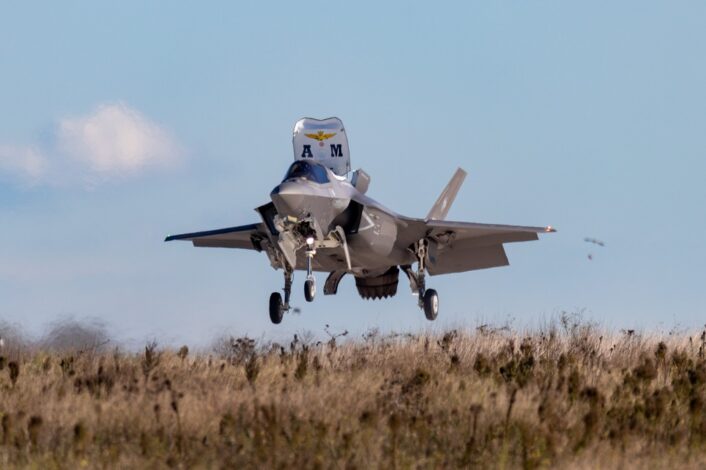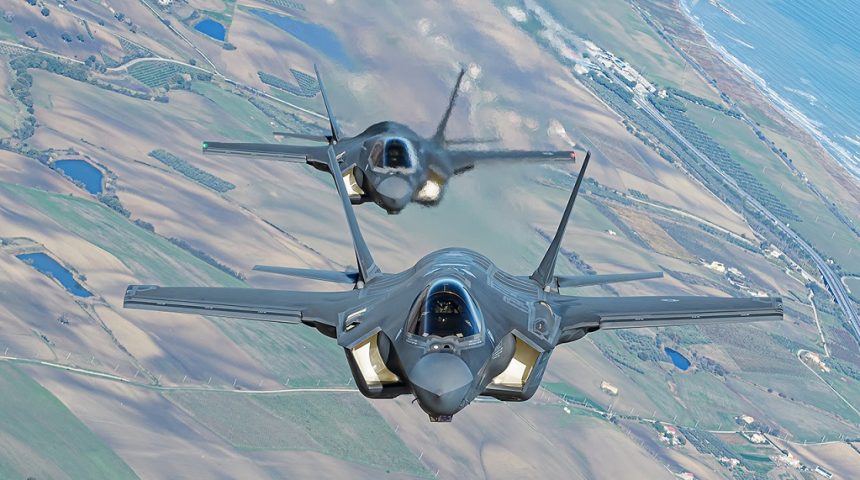Designed for 5th gen fighter jets, Falcon Strike 2022 increased interoperability and cooperation to obtain the air dominance, taking also into account the lessons learned from the current situation in Ukraine.
Exercise Falcon Strike 2002, held at Amendola Air Base, in southeastern Italy, is about to end after two weeks of intense training with Italian, US and Dutch F-35s. The exercise, the largest organized by the Italian Air Force this year, was also the perfect occasion to host the F-35 European Air Chief Meeting, which saw the participations of all the commanders of the air forces that have F-35s in their ranks.
We attended the Media Day of the exercise, where we had the chance to talk with the officers in charge of the exercise, while our contributor Alessandro Fucito also flew a photographic mission on a C-130J and captured the amazing air-to-air photos you can see in this article. We also had a unique chance to interview Lieutenant General Luca Goretti, Italian Air Force Chief of Staff, Lieutenant General Dennis Luyt, Commander of the Royal Netherlands Air Force and General James B. Hecker, Commander of U.S. Air Forces in Europe and U.S. Air Forces Africa.
“I want to thank all my colleagues from the United States and the Netherlands for being here for this very large exercise, they give us the possibility to show our strength in NATO, especially for this kind of crises we are seeing in Europe,” Gen. Goretti said. “We need to fight all together for freedom and we demonstrated since the beginning of the war that we are all united, and this exercise is another opportunity to show everybody that we are very committed to working together, build up our confidence and increase our knowledge and proficiency using the F-35 in Europe”.
Speaking with the Director of Exercise (DIREX), Colonel Vito Cracas, it emerged that Europe was lacking an exercise specifically focused on 5th gen. aircraft, their technical characteristics and training/operational implications. This was the reason why the exercise was first held last year and replicated again this year, before becoming a biennial exercise with the next iteration planned in 2024.
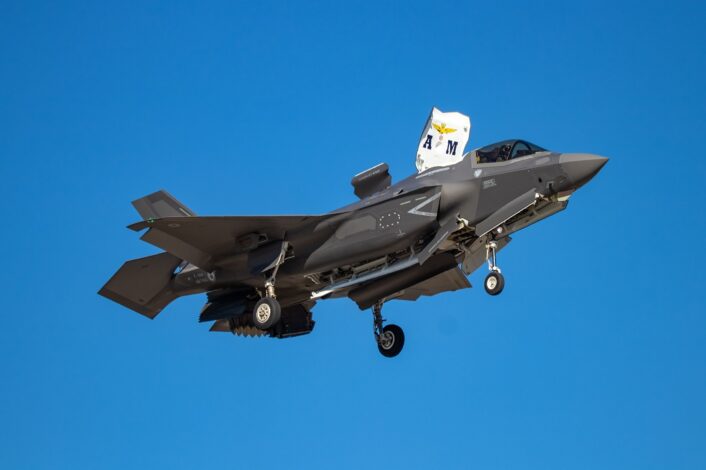
As we already reported, the exercise saw the participation of F-35s from Italy, US and the Netherlands and US F-16s in the Blue Forces, while almost all assets of the Italian Air Force were available for the Red Air. Col. Cracas also confirmed that Italian F-35s, both in the A and B variants, acted as adversaries during the exercise, as 5th gen aircraft are not considered a western prerogative anymore.
This follows the similar approach taken by the Red Flag exercises, which this year saw the Aggressors employing the F-35 for the first time against the Blue Forces. The DIREX confirmed to us that Falcon Strike is very similar to Red Flag and the foreign militaries that were at Amendola air base even called it an “European Red Flag”.
Over 50 aircraft including F-35A and B and 1000 military involved; these are the numbers of the exercise #FalconStrike 2022, organized by #ItalianAirForce with the participation of Italian Army and Italian Navy, involving several air bases throughout the country pic.twitter.com/5qjftZzh7R
— Aeronautica Militare (@ItalianAirForce) November 23, 2022
In a previous story, we mentioned that, according to insiders, the US F-22s currently deployed in Poland were expected to participate. Col. Cracas confirmed this, mentioning that last minute commitments prevented them from moving to Amendola. Had they made it to the exercise, it would have been the first time the Aeronautica Militare worked with the F-22 in Europe during a large-scale exercise, according to the DIREX.
By using the large airspace over the Tyrrhenian Sea east of Sardinia and the Salto di Quirra ranges, together with double digit Surface to Air Missile sytems, 4+ and 5th gen aircraft, the exercise simulated a demanding anti-access/area-denial scenario of a fictitious equal adversary. The scenario simulated the first days of war, with NATO responding to a crisis that quickly transformed in an armed conflict.
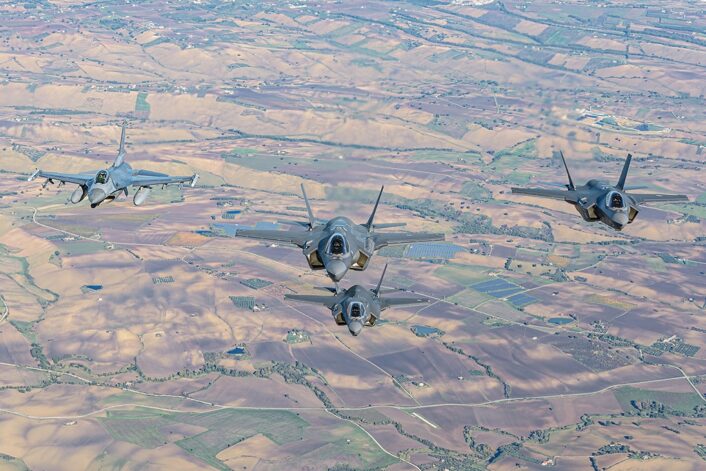
“In our business, it’s all about what we call “Day One effectiveness”, how effective we can be as a coalition on day one of any scenario,” said Lt. Gen. Luyt. “So when we fight together, we know what to do together, how to work together seamlessly and exercises like Falcon Strike are hugely important to create that day one effectiveness, so our aircrews know each other, they can work together in any scenario and also knowing that the F-35 will probably be at the frontline of any operation now and in the future.”
Given the “Day One” kind of scenario, the aircraft took full advantage of its Very Low Observability capabilities and also flew without the Radar Cross Section enhancers (and the DIREX even implicitly mentioned our article where we reported about this). The Suppression of Enemy Air Defenses (SEAD) was obviously one of the main roles of the F-35s, exploiting all its capabilities against the surface to air threat.
Volatile, Uncertain, Complex, Ambiguous and Rapidly changing; these are the scenarios of the current geo-political world context, where the Italian, Dutch and U.S. Air Forces have operated in the training exercise #FalconStrike 2022, organized by the #ItalianAirForce pic.twitter.com/Iq7FjYDVRz
— Aeronautica Militare (@ItalianAirForce) November 24, 2022
The main objective of the exercise was to train F-35 forces in a dedicated 5th gen scenario against a capable adversary, taking advantage of the most advanced technologies. The integration between 4th and 5th gen, contrary to the first reports, was given for granted during Falcon Strike 2022, as there are already other exercises dedicated to that.
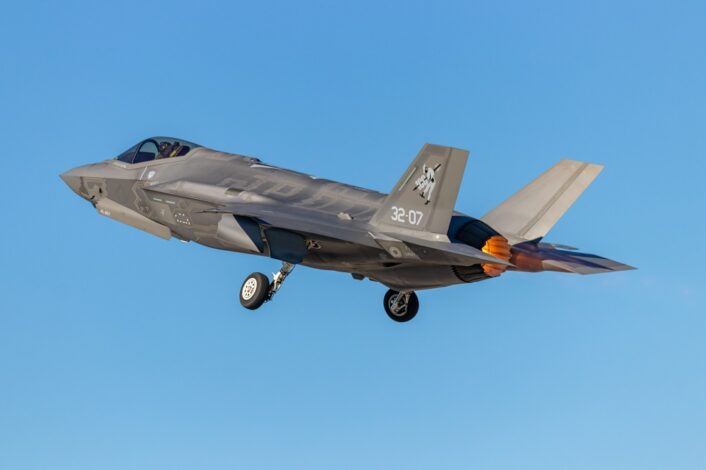
Anyway, Col. Cracas said that there is always this integration, even if it’s not the focus, as it is essential because the 4th gen aircraft are present in greater numbers than the 5th gen in the various air forces, as well as because the 4th gen can carry all the armaments the 5th gen can’t carry to maintain the VLO signature. The same concept was also mentioned by the Generals during the interview.
“Right now, we roughly have 140 F-35s in Europe, by 2034 we will have a little more than 600, but it’s going to take a while to get there”, said Gen.Hecker. “In the meantime, we need to use good interoperability and integration between both our 4th gen aircraft, like the F-16, and our 5th gen aircraft.”
Working alongside our @NATO allies at #FalconStrike 2022 to demonstrate the strength of integrating fourth and fifth-generation airpower! 🛫#StrongerTogether | #FSK22 | #PartnersAndAllies | @AirAviano | @usairforce | @ItalianAirForce | @US_EUCOM | @ThirdAirForce pic.twitter.com/cymR0vZvAY
— USAFE-AFAFRICA (@HQUSAFEAFAF) November 23, 2022
“Despite the fact that we are increasing the numbers of the 5th gen aircraft, we still own some 4th, so we need to cooperate and be interoperable among those guys. The more they learn by the 5th gen aircraft, the better they will be”, said Lt. Gen. Goretti. “Also, with all the F-35 pilots coming from the Typhoon or the F-16, there is a sharing proficiency that is building up because, if we need to do something, we all have to fight together, so there will be no differences, and the mutual cooperation and the interoperability can play a big role.”
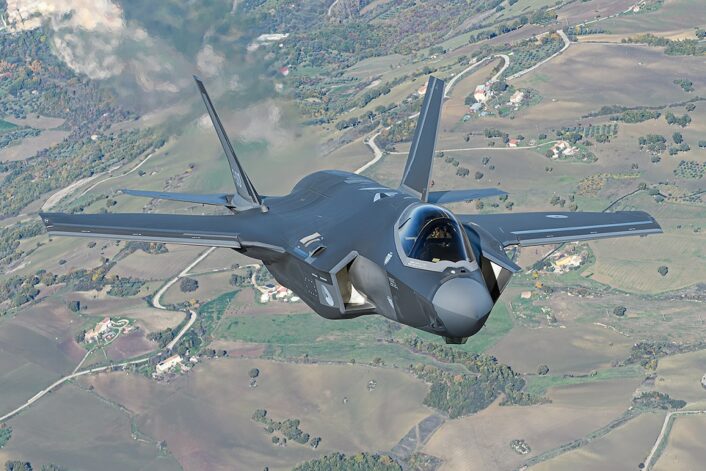
Another focus was also the maintenance side of the F-35 operations, with Italian maintenance crews working on foreign F-35s and vice versa, as we could see during the cross-servicing event held during the media day. This is also in line with the Agile Combat Employment doctrine of the US Air Force, and one of the many reasons the 495th Fighter Squadron was deployed with five F-35s to Amendola for the exercise.
“I think it’s really a warfighting imperative to be able to do that, there might be times when a US F-35 has to divert to another airbase, or maybe we can even plan on going to another airbase and we don’t have the maintenance or the equipment to go with them”, said Gen. Hecker. “We’re trying to make it interoperable, so if any F-35 nation can work with any F-35, no matter what nation it comes from, it can work on it, not just refuel it, but rearm it as well. We want to get to that stage in the game and this is the beginning of that.” He also confirmed that this was one of the topics on the agenda for the F-35 Air Chief Meeting.
#ItalianAirForce hosted the #F35 Air Chiefs Meeting, a forum on the 5th generation Fighter. Lt Gen Goretti, Chief of Staff of Italian Air Force, met the Air Forces Principals of Belgium, Canada, Denmark, Finland, Israel, the Netherlands, Norway, Poland, UK and the USA pic.twitter.com/2vpwIklbOh
— Aeronautica Militare (@ItalianAirForce) November 22, 2022
“If I have to deploy some aircraft in the Netherlands and I cannot perform a cross service team between my guys and the Dutch guys, I need to bring 100 people as well as the jets in the Netherlands, but if we are doing cross-servicing I can only deploy the crew chiefs. That means my deployment cell is 50 guys, 30 guys, and all the other things will be managed by them”, added Lt. Gen. Goretti. “Speed is the key for air power so, when we need to deploy, we have to fly faster and sooner, and if we have people there ready and waiting for us, we just need to send the jets and then we can manage also to bring some more people”. He also mentioned the similar Eurofighter “plug and play” which was recently used by German and Italian fighters in Romania during NATO missions.
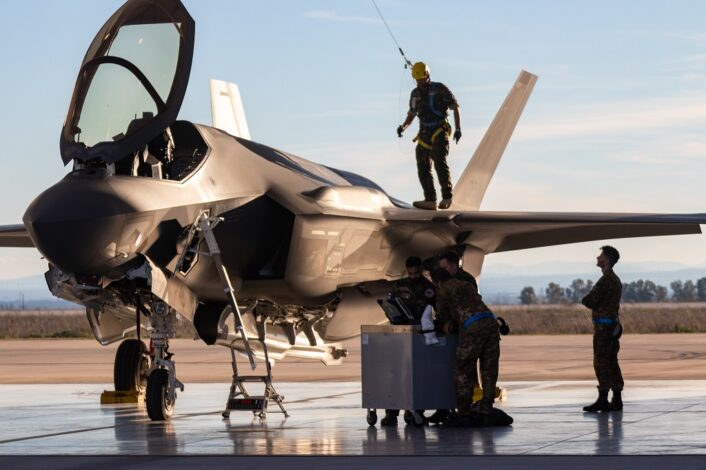
This interoperability is already present since the basic training at Luke Air Force Base in the US. The F-35 international Formal Training Units, in fact, see the pilots from different nations working together since the ground school. Both the Italian and Dutch commanders are very pleased with the training that is being provided at Luke, which is considered “a very successful and powerful formula” to initiate the pilots to the F-35 and have a standardization for all the F-35 community.
After that, pilots will explore different areas, with Lt. Gen. Goretti mentioning, for an instance, Italian pilots flying in northern Europe and Norwegian pilots flying in Italy so they can experience different scenarios that they are not used to. Pilots will also attend exercises like the Tactical Leadership Programme to build up the confidence that will make them future package commanders, before moving to different kind of exercises like Falcon Strike where they will prove what they learnt from the TLP and apply it in more advanced scenarios.
Insieme con i nostri alleati, voliamo ogni giorno più in alto. É questo lo spirito dell’esercitazione #FalconStrike 2022 organizzata in Italia dall’#AeronauticaMilitare, con la partecipazione di Usa e Paesi Bassi.#latuasquadrachevola pic.twitter.com/6OAsGo03UG
— Aeronautica Militare (@ItalianAirForce) November 20, 2022
Like Lt. Gen. Luyt said, exercises like Falcon Strike and the Dutch Frisian Flag are “like the Champions League of the exercises where our crews, not only the pilots but also the technicians, train to the highest levels and prepare for any conflict.” We also asked about the possibility of a European training centre or a FTU for all F-35 pilots. “We are still just at the beginning of this new era of using F-35s in training and operations and sustaining it, in the next couple of years we will figure out how we want to do this”, told us Lt. Gen. Luyt. “As an F-35 community, we will be always thinking about what is next, how do we become smarter and operate with the F-35, but for now we are really happy with the training set we have in the US.”
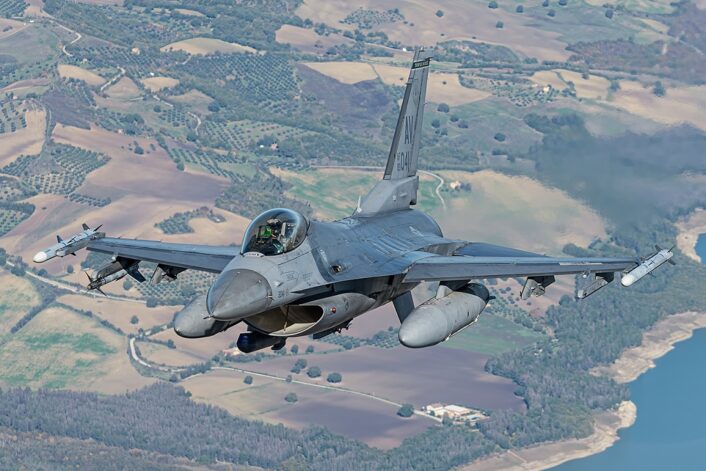
The situation in Eastern Europe and the conflict in Ukraine were also one of the topics, also influencing the scenarios planned for the exercise. “We slightly changed some scenarios in relation to the lesson learned from the Ukrainian scenario,” said Lt. Gen. Goretti. “Together with our American and Dutch colleagues we created specific activities to see how this 5th gen aircraft can operate best. We also have to make sure there is the interoperability between 4th and 5th gen so they can all be employed for the air dominance, which is the keystone for the success of any operation”.
Command and Control for exercise #FalconStrike 2022 organized by #ItalianAirForce at 32nd Wing Amendola (FG) is provider by Italian Deployable Air Surveillance And Control System (IT-D-ASACS), platform that can be integrated with aircraft G-550 CAEW pic.twitter.com/XpwYGYGbhA
— Aeronautica Militare (@ItalianAirForce) November 21, 2022
A similar concept was also stated by Gen. Hecker: ”When you look at what’s going on in Ukraine, neither country has been able to get the air superiority and we see what the result of that is, several hundreds of thousands of casualties in less than a year”, he said. “If you compare that to the number of casualties we had in 20 years of Afghanistan, it just blows it out of the water, and it really shows the importance of air superiority. What the F-35 is going to help us with is gain and maintain that air superiority, should we have to go to war with somebody else.”
The three Generals all agreed that the situation in Ukraine underlined the importance of air dominance, while also a strong and powerful message is being sent to Moscow and any opponent of NATO with the planned presence of 600 F-35s in Europe and the interoperability and cooperation among all the countries that operate the 5th gen fighter jet.
